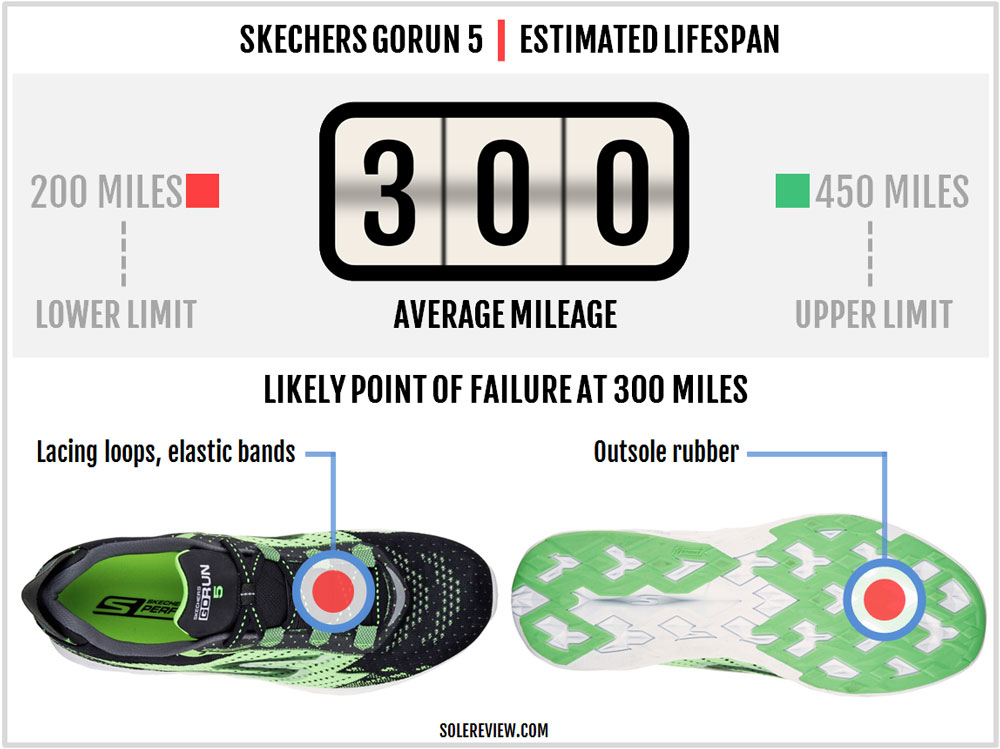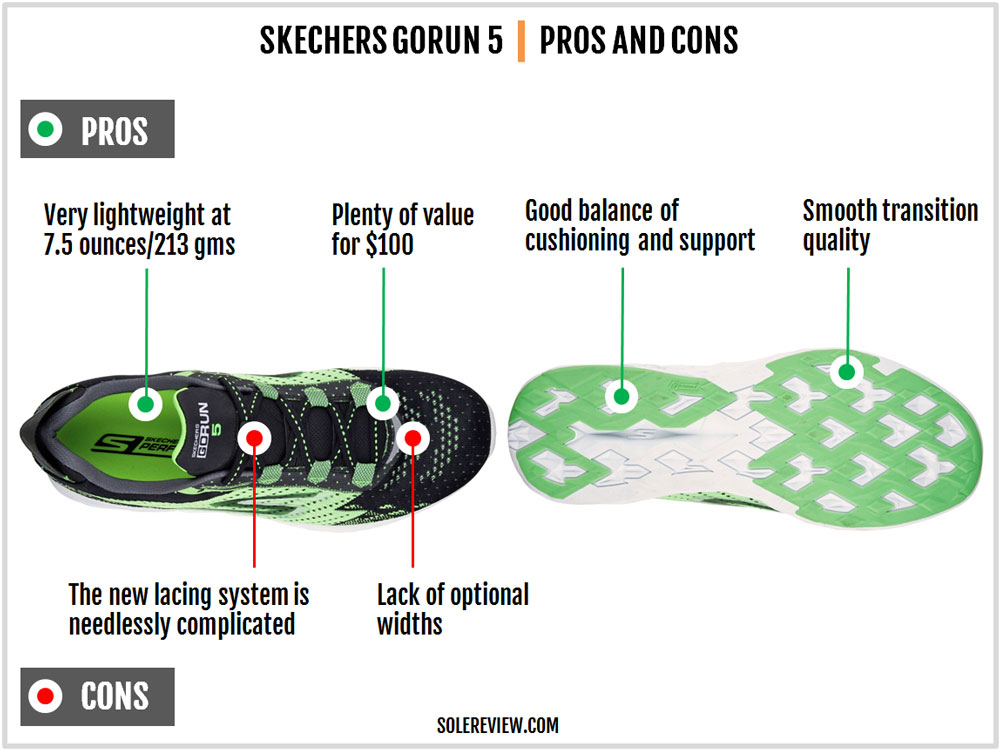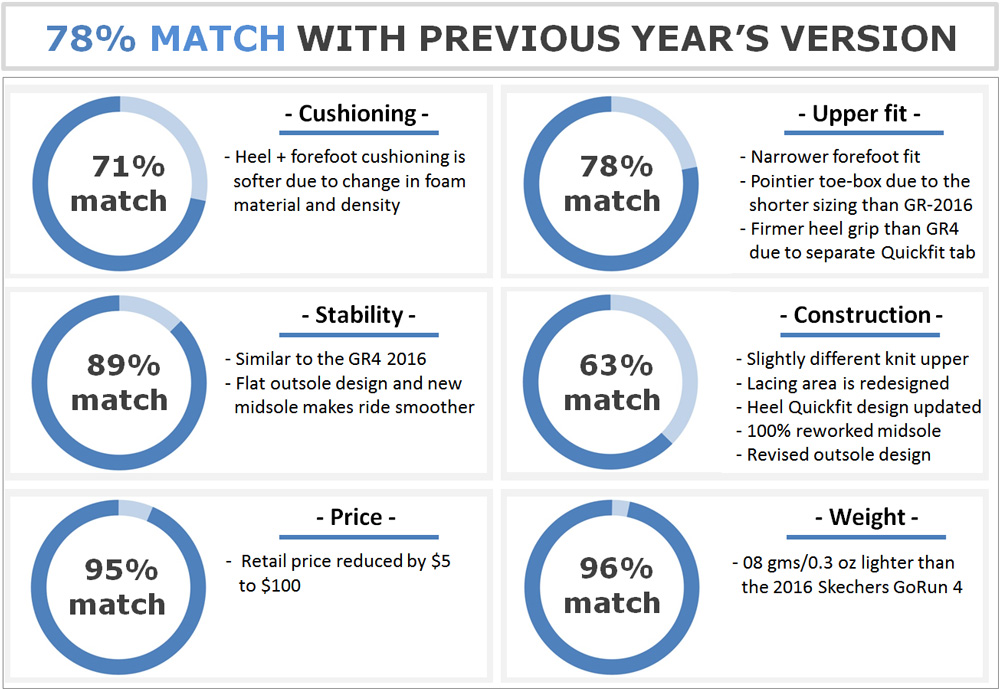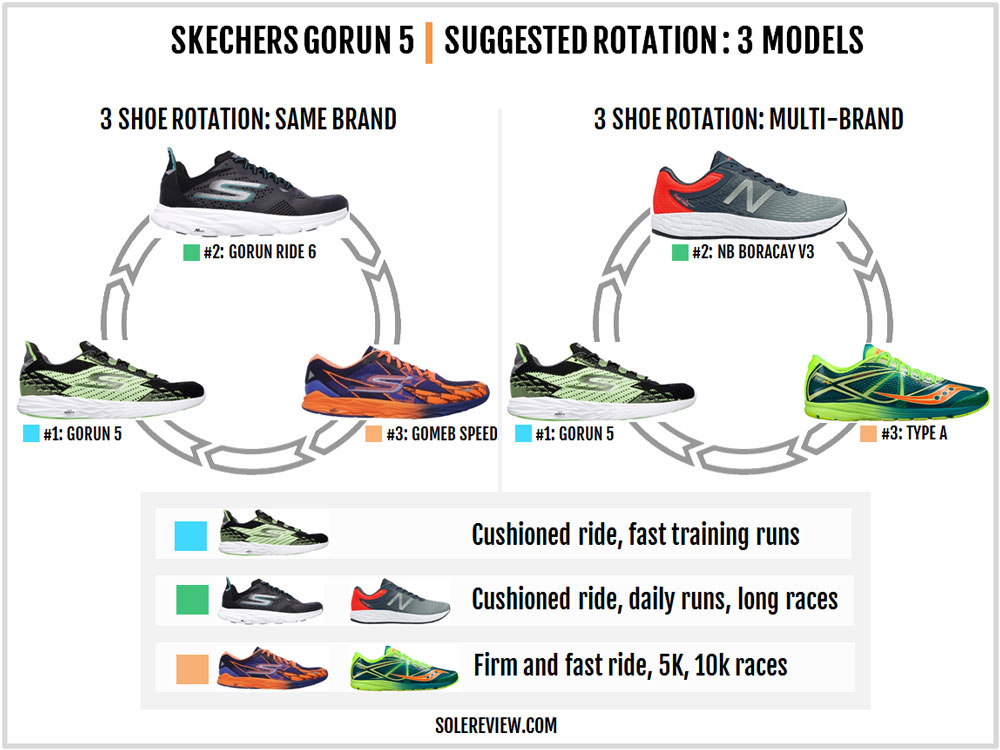INTRODUCTION
There were two versions of the GoRun 4, one each for 2015 and 2016. The first version was reviewed here, and the second iteration used the same name but with a brand new GoKnit upper.
And a knit upper is what most of the Skechers Performance line is switching to nowadays; that’s obvious when you look at the new Razor or the GoMeb Speed 4. Even before the knit design arrived, Skechers was using a minimal mesh upper with thin overlays, so the evolution has been mild from a functional perspective.
Of late, Skechers has been adding a lot of new shoes to its performance running assortment, so it’s worth explaining what each model is supposed to do.
For quite a while, three Skechers models represented the brand’s neutral road running line. You had the Skechers GoRun Ride which was marketed as a cushioned trainer; the minimal GoMeb Speed represented the speedier side of things.
As a lightweight training shoe, the GoRun series bridged the gap between the GR Ride and GM Speed. Recently, the GoMeb Razor showed up, a product which further narrows the chasm between the GoRun 5 trainer and the GoMeb Speed 4 racer.
There’s a lot of part-sharing going on between the GoRun 5 and the Razor. The midsole and outsole are exactly the same, except that the Razor’s midsole has a firmer foam density than the GoRun – the latter is noticeably softer in comparison.
The Razor’s fit is also slightly more relaxed than the GoRun – though we’re not sure whether this was intentional on Skechers’ part.
If you ask us, the Razor and Gorun are too close – at least from a positioning perspective. Admittedly, there are differences in the ride and fit quality between the two. But if you wanted something more cushioned than the Razor, then you have the GoRun Ride 6, don’t you?
But we’ll leave it up to you to decide which one to pick as your training shoe; all we can do here is lay out the facts for you.
And how does the GoRun 5 compare with the GoRun 4 2016?
The headlining act is the midsole and outsole update, which makes a huge difference in how the new GoRun rides. The new sole unit gets rid of the pillar cushioning design, and also changes the midsole foam formulation. These tweaks make the ride softer and responsive.
The upper fits slightly shorter in sizing than the GR 2016, the result of an updated ‘Quickfit’ design.
DESIGN AND MATERIALS
The beauty about non-stretch knit uppers is that what you see is mostly what you get. You’ll seldom encounter hidden components, treacherous inner seams or any other surprises.
As long as the knit upper isn’t an elastic kind, the initial expectations around fit and feel match closely with the final impression after a few weeks of usage.
This isn’t to say that there won’t be any fit differences between two shoes sharing a similar knit upper. The GoRun 4 2016 and the GoRun5 2017 is case in point. While both successive GoRun models share a similar, non-stretch ‘GoKnit’ upper, the latest GR 5 fits smaller because of changes made to the heel.
Back in 2015, Skechers introduced its ‘Quickfit’ heel clasping system which was just another fancy sounding term for an Achilles area with a large hole. In theory, this opening made a convenient hook for your fingers to pull on the heel area.
The GR 4 2016’s Quickfit was integrated into the back heel. On the GoRun 5, there’s a separate synthetic pull tab which is stitched over the Achilles area.
This means that the mesh collar curves slightly inwards, which in turn pushes the foot forward. The result? The GoRun 5 has slightly shorter sizing than the GR4.
Otherwise, there isn’t much change in the heel mesh and foam padding. The collar walls are sparsely padded as they were before; though that doesn’t get in the way of the heel grip quality. There’s a hard internal counter shaping the heel, and that’s paired with a semi-soft stiffener in the toe-area.
The tongue and lacing area receives a radical redesign. The GR5 incorporates a padded tongue instead of the raw edge version used on the GR4, and the lacing system is completely overhauled – though in an unusual way.
The laces used are the same flat type used on the GR4. That said, the lacing now passes through broad fabric loops instead of eyelets. The GoRun 5 also cuts down on the number of lacing rows from seven to just five, hence increasing the space between each row.
As if to compensate for the reduced rows, the lacing area is bridged with two elastic bands. These bands don’t go all around the midfoot; they just span over the tongue. There’s minimal tongue slide because of its wide flap, and the newly added padding helps too.
With all these changes, getting the lacing cinch right is bit of a work compared to the simple layout of the GoRun 4. The lace-loops also appear flimsy compared to the traditional (and dependable) eyelet design. The base over which the loops are stitched are strengthened with a laminate, but the loops themselves are not.
Other details like the reflective trims and the fused Skechers logos carry over from the GoRun 4. The shiny bits on the GR4’s toe-box have been relocated to the front of the first lacing row, and the heel bits are now a part of the Quickfit pull tab.
Based on what we’ve seen on the GoMeb Razor, Skechers is letting go of the distinct rocker-shaped midsole design. Like the Razor, the GoRun 5’s outsole still says ‘M-Strike’ under the midfoot, but the midsole has transformed into a flat design.
It’s not only the rocker-shape which is history but the foam compound and density too. The new GoRun uses the 5GEN EVA foam variant instead of the GR4’s Resalyte EVA. The GoRun 4 also had a separate foam component clasping the midfoot. Well, that’s gone now. The entire midsole is now made of a single-density foam.
What’s interesting is that the 5GEN midsole foam is compression molded instead of GR4’s injection molding. So along with the foam material, the choice of construction also alters the ride quality.
There’s a likelihood that the new midsole combines injection and compression molding by using a preform method, but we can’t be sure. Read this solereview article for a detailed breakdown of different manufacturing methods.
The effect of molding and material change is evident in the new foam’s increased cushioning and responsiveness feel. This upside is remarkable considering that the GoRun 5 no longer features the pillar cushioning (which, logically, should produce a softer ride) of the past GoRun models, and instead features a flat profile.
There’s a lot more rubber used on the outsole. Except for a small patch under the midfoot, the forefoot and rearfoot are covered with a thin sheet of rubber. Exposed windows cut into the outsole interlock with the 5GEN midsole, resulting in a cohesive cushioning behavior.
The outsole lacks an aggressive lug design, but the shoe grips well on dry surfaces. However, running in wet conditions isn’t optimal with the GR5, so that’s something you should know.
The midsole is topped off with a molded insole which has a relatively flat profile; this hasn’t changed. Most Skechers performance products (except the 8 mm Forza) have a 4 mm heel-to-toe gradient, and the GoRun 5 is no different. This makes nearly all Skechers running shoes an ideal choice for runners who seek a cushioned ride in a low offset package.
Both the GoRun 5 and Razor share the same midsole and the outsole design. The only difference is that the GR5’s foam density is softer than the Razor, hence affecting the cushioning quality. The cheaper GoRun also does not come with the cosmetic paint job which the Razor’s midsole has.
One of the peeves we had with the older pillar based design was that footstrike and transition areas took a lot of the brunt. Some pillars took a lot more abuse than the rest of the midsole; in other words, the wear and tear was localized. The rocker shape of the midsole had a role to play too.
With the GoRun 5’s midsole evolving into a flatter shape, the wear and tear is spread evenly. The larger sheet of rubber also helps minimize the localized wear of the outsole. The midsole should also hold its cushioning properties better than the GoRun 4 as it is now a denser, compression molded type.
The outsole is thin, so don’t expect the GoRun 5 to be super durable. You should be able to squeeze 300 miles out of the shoe, with wear and tear happening evenly on the midsole and outsole.
If there’s anything which makes us nervous about the GR5’s long-term durability, it’s the fabric speed lacing loops. They do not feel as sturdy as regular eyelets, and besides, they are placed wider which only exerts more pressure on them. This makes them susceptible to fraying or stress damage.
UPPER FIT AND FEEL
If you find the GR5’s toe-box to be shallower than the GR4, then you’re not imagining things. The redesigned heel ‘Quickfit’ tab curves the heel inwards and pushes the foot forward in relation to the GR4. Thus, while the toe-box isn’t shallow per se, it feels so.
The midfoot fit is a bit of a give and take. The GR5’s last has a snug feel to it and tries to make up for the shortcomings of the lacing system.
The reduction of lacing rows (over the GR4) and the use of broad loops isn’t the best lacing solution. Getting the lacing pressure right requires some effort, and the elastic bands apply needless top-down pressure where there should be none. In our view, the traditional seven-row lacing used on the GR4 and Razor works far better.
The heel is molded narrow, so despite the lack of abundant foam fill, the collar grips well around the ankles.
The upper fits true to size, but if you want the same fit as the GR4, then get a half size larger. The new heel design pushes the foot forward, leading to a reduction in the toe-box room.
The forefoot feels snug on the sides but does not cause any discomfort. The knit upper will open up slightly over time, so you need to account for that too.
RIDE QUALITY AND BEHAVIOR
The GoRun 5 is noticeably softer than the GR4. The new 5GEN foam material has a huge role in the changed ride experience, and design features such as the sidewall grooves and the insole help too. The sidewalls have these sharp grooves which make the midsole easier to compress, and the molded insole provides the first layer of cushioning.
The softness of the GoRun 5 is just right. It is not mushy at all, and the softness tapers from the heel to the forefoot. The rearfoot feels more cushioned in comparison to the forefoot, where a thinner midsole stack makes it firmer. The thin rubber also blends in nicely with the midsole and does not make itself felt as a separate component.
Being what it is, the GR5 is a versatile shoe for a variety of runs. Be it a 10k or a marathon, the Skechers GoRun performs with aplomb. The only thing you need to be careful is the low heel drop of 4 mm. This can be a problem (initial soreness, etc.) if you’re transitioning from a 8 – 10 mm drop shoe.
Using the new 5GEN midsole dials up the GoRun’s responsiveness by a notch or two. Admittedly, the 5GEN EVA foam has nothing on the adidas Boost or Saucony Everun material, but as far as Skechers is concerned, it is an improvement.
The legacy pillar cushioning (used on the GR4) felt flat in comparison. The GR5 has a little more bounce in it, and that’s due to the compression molded 5GEN and the rubber outsole which allows the midsole to rebound better.
The changes in the midsole and outsole design influences the transition and support character too.
Transitions on the GoRun 5 are smoother and better than the earlier GoRuns. The update to a single-density midsole has helped, and so has the change in the foam material. The flat outsole below assists in a seamless progression along the length of the shoe. The forefoot is firmer than the rear, so toe-offs come quick and easy.
The midsole has a balanced design throughout, so there’s nearly no bias. This makes the GR5 fairly supportive, and the flatter midsole profile makes the ride feel more planted.
If you need a faster shoe, then try the GoMeb Razor. It has the same midsole as GoRun, but only firmer.
PROS AND CONS
For a retail price of $100, the Skechers GoRun 5 is good value for money. It features a smooth-fitting knit upper, a design feature which is usually available in other brands at a higher price.
The midsole not only rides smooth but has the just-right amount of softness. The new 5GEN EVA foam has a slightly bouncy feel to it, which makes running in the GR5 an engaging experience. Moreover, it’s pretty lightweight at a respectable 7.5 ounces for a half pair of US 9.
There are two areas of potential improvement. The first would be fixing the novel lacing system which combines fabric loops with elastic bands. This seems like a change just for the sake of it. A simple lacing system would have worked just as well, and probably better.
So far, Skechers has shied away from offering optional widths. They should at least offer the choice of a 2E (wide).
SUMMARY
The 2017 GoRun 5 is a major model update. The new midsole and outsole is softer and responsive than the outgoing version. This happens due to the new foam material and the overall midsole design which has a flatter profile than the previous rocker shape.
Transitions are smoother too due to the updated outsole’s better ground contact, and the new model is lighter than the 2016 edition by 0.3 ounces.
Adding the ‘Quickfit’ pull tab as a separate piece results in the foot being pushed forward. This makes the 2017 GoRun fit slightly shorter in size than the GoRun 4.
There are multiple changes made to the tongue and lacing design; the tongue flap moves to a padded design versus the last year’s raw edge. The number of lacing rows is reduced, and traditional eyelets are replaced with flat straps and dual elastic bands.
The last year GR4 had an odd price of $105, and the 2017 version corrects that to a simpler $100 price.
RECOMMENDED ROTATION
In theory, the trio of the GoRun Ride 6, GoRun 5 and the GoMeb Speed 4 should work well from a rotational perspective. But then, the lines are blurred between the Ride 6 and the GR5.
That has a lot to do with the GoRun 5’s new midsole which makes it softer than its previous version, and thus the Ride and GR5 aren’t differentiated enough from a cushioning standpoint. The Ride 6 still sticks to the legacy pillar-cushioning equipped midsole.
Just getting the GoRun and GoMeb Speed will do. With this two-shoe arrangement, you get a cushioned trainer and a firm speedster. Perhaps Skechers will bring back the GoRun Ultra Road model. If that happens, a three shoe rotation of the Road Ultra, Ride 6 and the GoRun 5 will play well together.
The New Balance Boracay V3 complements the GoRun 5 with its thicker midsole stack while maintaining the same 4 mm offset. It has a snug upper like the GoRun, and the single-density midsole protected with a full contact rubber outsole delivers a similar transition quality.
If you want to skip the GoMeb Speed, then the Saucony Type A is a good addition as a race shoe meant for distances up to 10k. Again, no change in the heel offset – the Type A has a 4mm heel offset on a firm riding midsole.
OTHER LIGHTWEIGHT NEUTRAL TRAINERS
Since the GoRun 5 and Razor share the same midsole, the Razor is the closest shoe to the GR 5. Barring the firmer ride and slightly looser upper, the 4 mm drop midsole and knit upper construction are shared elements with the GoRun.
Outside of Skechers, the Saucony Kinvara 8 have a few common characteristics. Like the GoRun, the Kinvara 8 has a 4 mm heel-to-toe offset and a ride which is neither too soft nor too firm.
The Hoka Hupana comes close to the GoRun 5. It has a knit upper, and well-cushioned shoe with a 5 mm offset which for once, does not feature Hoka’s signature supersize foam midsoles. The Hoka Tracer is another cushioned trainer with a 4 mm offset so that a shoe worth looking at too.
Next in line is the New Balance Zante V3. Its 6 mm drop is close to the GR 5, and the padded ride quality puts it in a similar class as the Skechers shoe. It’s heavier than the GR 5 by a full ounce, though.
There are others, albeit with a higher heel-to-toe gradient. The Asics Dynaflyte offers a firm and mildly responsive ride, thanks to its Flytefoam midsole; and the Brooks Launch 4 has a much higher drop of 10mm and a firmer ride. The differences aside, both the Dynaflyte and the Launch 4 are competent training shoes.
The adidas Boston 6 is a perennial favorite as a cushioned training shoe. The Boost foam blended with a firmer EVA rim produces a perfect balance of cushioned and fast, and the Continental rubber outsole is very hardy. It has a much higher offset of 10 mm, versus 4 mm of the GoRun 5.
Among the rest, the Mizuno Sayonara 4 is of the same category, though only in spirit and not the ride quality. The Wave Plate insert in its midsole makes the ride firmer and different than the others.
If you have a lot of cash, and are looking for a more engaging 4 mm trainer, then buy the Saucony Freedom ISO. It is in a different price class altogether, but is an alternative nonetheless.















